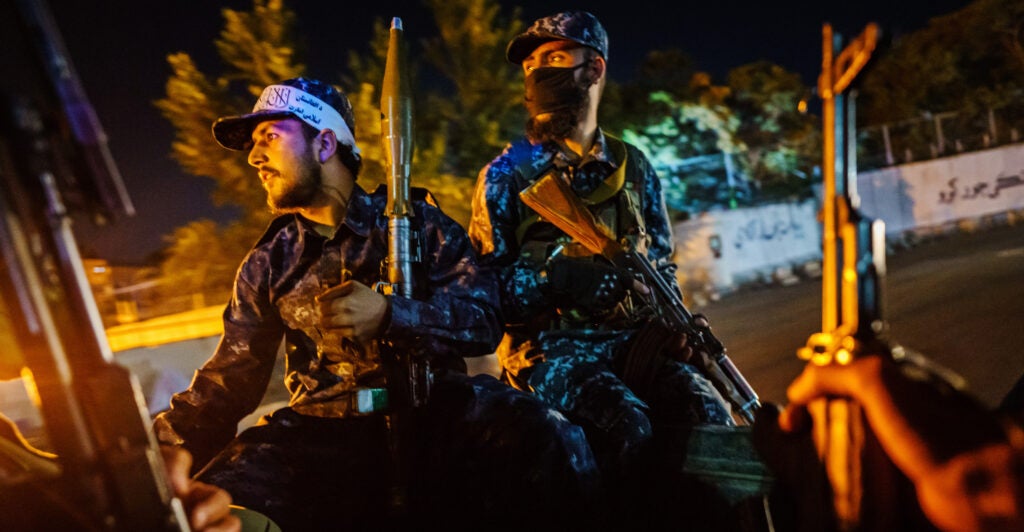When the Taliban assumed control of Afghanistan last month, the group took possession of a U.S.-funded weapons stockpile worth tens of billions of dollars.
The U.S. invested nearly $83 billion in bolstering the Afghan National Defense and Security Forces, more than $24 billion of which went to funding weapons, vehicles, and other equipment, according to a Special Inspector General for Afghanistan Reconstruction report published in July. The amount of funding for weapons, vehicles, and equipment is based on a 2017 Government Accountability Office estimate that roughly 70% of the investment went toward other budget items, such as training.
In the aftermath of the shocking collapse of the Western-backed Afghan government last month, U.S. defense officials estimated that Taliban militants took dozens of aircraft, including Black Hawk helicopters, and thousands of vehicles, communications equipment, and weapons.
Republican lawmakers demanded the Biden administration provide them with a full accounting of the equipment that was in the Taliban’s possession, while GOP members of the House Armed Services Committee introduced a bill requiring the White House to share the information with Congress.
“No one has any accounting of exactly what survived the last weeks of the collapse and fell into Taliban hands, and even before the collapse, [the Special Inspector General for Afghanistan Reconstruction] had publicly reported no accounting was possible in many districts,” Anthony Cordesman, an analyst at the Center for Strategic and International Studies, told The Washington Post.
“In rough terms, however, if the [Afghanistan National Defense and Security Forces] could not sustain it without foreign contractors, the Taliban will have very serious problems in operating it,” he continued. “That covers most aircraft and many electronics and heavier weapons.”
While Cordesman predicted the Taliban would have trouble operating the advanced equipment, included in the U.S. cache left behind, Republicans worried the Taliban would provide that complex hardware to U.S. foes China, Russia, and Iran.
Overall, the U.S. gave more than 599,690 arms, including rifles, pistols, machine guns, and rocket-propelled weapons; more than 16,191 pieces of surveillance equipment, including night-vision goggles and radio monitoring systems; and more than 208 aircraft, including helicopters, cargo airplanes, fighter jets, and surveillance drones to the Afghanistan National Defense and Security Forces since 2004, according to the GAO.
The July special inspector general’s report estimated that 80% of the aircraft given to the Afghanistan National Defense and Security Forces was usable.
President Joe Biden said in July that the Afghanistan army would be able to withstand Taliban offensives since the U.S. had provided it with “all the tools, training, and equipment of any modern military.”
Some experts have also argued that the billions of dollars used to train Afghan soldiers may indirectly be used by the Taliban, according to the Los Angeles Times. Some Taliban fighters seen in recent videos posted online were likely trained by the U.S. military, based on their behavior.
“The stance, the way they’re holding the rifles, the trigger finger, how it’s flat and laying outside the trigger guard,” Dan Grazier, a defense policy analyst for Project on Government Oversight, told the newspaper. “That’s hallmark American military training right there.”
The tens of billions of dollars worth of equipment, aircraft, and weapons; the billions of dollars worth of U.S. training; and alliances with several powerful nations place the Taliban in Afghanistan among the most well-equipped Islamic terrorist groups in the world.
In 2018, Lebanon-based Islamic terrorist group Hezbollah had an estimated income of $1.1 billion, making it the richest terrorist organization in the world, according to a Forbes estimate. The Taliban was second on the list, earning an estimated $800 million per year.
Comparatively, the U.S. gave the former Afghan government anywhere between $3 billion and $11 billion every year since 2010, the special inspector general said. The U.S. provided an average of $5.4 billion per year to Afghanistan since 2010.
While the U.S.-funded weapons and equipment won’t put the Taliban-governed Afghanistan among the most funded governments in the world, it does give the nation access to a weapons stockpile that could rival that of many fellow Middle Eastern nations.
For example, Bahrain, Lebanon, Jordan, and Egypt have annual military budgets of $1.4 billion, $1.9 billion, $2.1 billion, and $4.5 billion, according to data compiled by the Stockholm International Peace Research Institute.
Iran’s military, the largest Islamic militancy in the world, had a budget of $15.8 billion last year, the institute’s data showed.
But the Taliban is also expected to sell U.S. weaponry it obtained via Middle Eastern smuggling networks, The Wall Street Journal reported. The equipment, therefore, could find its way to other terrorist groups and U.S. enemies.
“These newly seized weapons can follow existing routes to flow throughout Afghanistan and beyond its borders,” Lauren Woods, director of the Security Assistance Monitor at the Center for International Policy, told The Wall Street Journal. “Our weapons monitoring and inventory processes are insufficient to prevent them from being diverted and misused.”
Rep. Mike Waltz, R-Fla., said the Taliban will probably keep most of the weapons, however, because that type of stockpile makes its military more powerful, according to The Wall Street Journal.
“Having a lot of stuff equals power,” Waltz told the Journal. “I see them holding on to it and preparing for what’s to come.”
The Department of Defense didn’t immediately respond to a request for comment.
Content created by The Daily Caller News Foundation is available without charge to any eligible news publisher that can provide a large audience. For licensing opportunities of this original content, email licensing@dailycallernewsfoundation.org.
Have an opinion about this article? To sound off, please email letters@DailySignal.com and we’ll consider publishing your edited remarks in our regular “We Hear You” feature. Remember to include the url or headline of the article plus your name and town and/or state.
